'Alien' Comet Is A Spaceship In Disguise Says Harvard Scientist - And It's Headed To Earth
Professor Avi Loeb theorizes it could be an artificial probe due to its rare retrograde orbit, planetary flybys, and precise alignment with Earth's orbital plane

A Harvard astrophysicist has suggested that a newly discovered comet passing through our solar system might be an alien spacecraft in disguise.
The claim by Professor Avi Loeb has split opinion in the scientific community, with most astronomers insisting the object, named 3I/ATLAS, is a natural comet rather than extraterrestrial technology.
Interstellar Visitor
Discovered on 1 July 2025, 3I/ATLAS is only the third confirmed interstellar object to pass through our solar system, following ʻOumuamua in 2017 and 2I/Borisov in 2019. It is travelling at about 210,000 km/h (130,000 mph) and has a 24 km-wide gas coma, according to NASA.
Scientists at NASA and the European Space Agency have classified it as a comet based on its physical characteristics. The International Astronomical Union's Minor Planet Center confirmed that it follows a hyperbolic trajectory, meaning it originated outside the solar system and will leave again, confirming its interstellar status.
Loeb's Theory
Professor Loeb, working with Adam Hibberd and Adam Crowl, outlined his theory in a paper titled Is the Interstellar Object 3I/ATLAS Alien Technology?. They note the comet's rare retrograde orbit, its close encounters with Venus, Mars and Jupiter, and its unusually precise alignment with Earth's orbital plane with odds they estimate at below 0.005 per cent.
Based on these factors, they suggest it could be an artificial surveillance probe designed to pass near planets and possibly deploy instruments. Loeb stresses that his idea is meant as a theoretical exercise, not a confirmed scientific conclusion.
The Scientific Consensus
Most astronomers reject the alien hypothesis. Darryl Seligman of Michigan State University, who led the first quantified study of 3I/ATLAS, told Live Science, 'All evidence points to this being an ordinary comet that was ejected from another solar system, just as countless billions of comets have been ejected from our own solar system.'
Samantha Lawler of the University of Regina called the theory 'nonsense on stilts' and said it undermines serious scientific work, according to Space.com.
NASA's Jet Propulsion Laboratory reports that 3I/ATLAS shows no signs of artificial propulsion or unusual acceleration. Its photometric data and dust coma match the profile of a natural comet. The European Space Agency agrees, and NASA has confirmed there is no threat to Earth, as the object will pass no closer than 130 million miles.

Could It Pose a Threat?
Loeb speculates that if the object were artificial, it could pass behind the Sun in late October, using the Sun's glare to hide its activity or harness solar energy. In theory, any redirection towards Earth would have to occur during this period, but the comet's speed makes interception by current spacecraft impossible.
Loeb admits that the most likely outcome is that 3I/ATLAS is a completely natural comet. No peer‑reviewed evidence indicates artificial propulsion, and no radio signals or unusual manoeuvres have been detected.
A History of Controversy
Loeb previously suggested that ʻOumuamua might be alien technology due to its unusual shape and unexplained acceleration. That proposal led him to found the Galileo Project, which searches for signs of extraterrestrial technology, The Guardian reported.
His critics argue that such claims can distract from evidence‑based research and mislead the public. Astronomers maintain that extraordinary claims require extraordinary proof, which they say Loeb has yet to provide.
For now, observatories worldwide, including the European Southern Observatory in Chile, continue to track 3I/ATLAS as it approaches its closest point to the Sun in late October. Until clear evidence emerges, the prevailing scientific view remains that it is behaving exactly as a natural comet should, not a visiting alien craft.
© Copyright IBTimes 2025. All rights reserved.





















